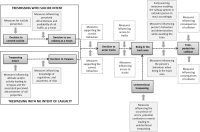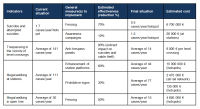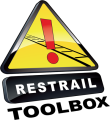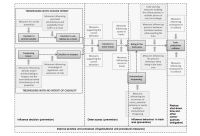 Once the target situation has been analysed and understood in depth, you can refer to the second section of this Toolbox (Specific guidance) to select the measures or combination of measures which are most appropriate and coherent with the policy of the RU, IM, national prevention strategy, etc.
Once the target situation has been analysed and understood in depth, you can refer to the second section of this Toolbox (Specific guidance) to select the measures or combination of measures which are most appropriate and coherent with the policy of the RU, IM, national prevention strategy, etc.
The information collected during the previous two steps should now be transformed into information that supports the process of decision making and selecting measures. It should help you select the optimal family of measures and envisage the most appropriate specific measures within the family.
For any potentially selected measure, it is important to consider at least the following questions and issues.
| Actions | Questions to be answered | Issues to be considered |
|---|---|---|
| Title of measure 1 / or combination of measures | Where is it implemented? | -* within target area (e.g. physical measures) -* elsewhere (e.g. education and campaigns) |
| What proportion of target incidents does the measure cover? | -* a rough estimate is enough -* e.g. what percentage of trespassing in the target location -* e.g. what percentage of suicides and attempted suicides in the target location | |
| What is the estimated effect on target incidents? | -* a rough estimate is enough -* estimated percent reduction in incidents covered by the measure -* e.g. percentage reduction of trespassing in the path where the measure is implemented | |
| Are there other significant effects? | -* effects on the environment -* acceptability issues -* integration with other measures | |
| What is the cost of the measure? | -* rough estimate is enough -* implementation and maintenance | |
| What should be taken into account when planning implementation? | -* need and organisation of maintenance -* features that may impede implementation or impair effectiveness -* cooperation between organisations -* effects on railway operations | |
| Title of measure 2 | same as above | same as above |
| Title of measure 3, 4, 5, etc. (if needed) | same as above | same as above |
For some of these questions the Toolbox provides some answers in the description of each specific measure. Consequently, in order to see how a particular measure could be implemented or to increase its chances of success, you should refer to the next section of the Toolbox (Specific guidance) which provides a detailed overview of the whole list of measures recommended by RESTRAIL . However, before doing so you may find it useful to refer to the model below.
This is a model of the chain of events leading to railway suicides and trespassing accidents and corresponding classes of preventative measures. It could help you to better decide what type of effect mechanism (impact) you need to achieve with your intervention. There may be at least 9 different steps and antecedents in the chain of events leading to railway suicides and trespassing accidents. The model proposes different types of measures that can be used in each phase of the suicide or trespassing process to prevent the events to occur and to mitigate the consequences.

- A model of the chain of events leading to railway suicides and trespassing accidents and corresponding classes of preventative measures (Burkhardt, Rådbo, Silla, & Paran, 2014)
Because the model includes 9 different antecedents and 11 possible categories of measures, some end-users may find it too analytical and detailed. Therefore, the Toolbox refers to four broader groups of events in the chained process and regroups the measures according to only 5 effect mechanisms:
- Measures to influence decision and intent;
- Measures to deter access to the tracks;
- Measures to influence behaviour in the track area;
- Measures to reduce post-incident consequences (e.g. shut-down time);
- Measures to improve practice and processes.
The first three categories concern suicide and trespass prevention, the fourth refers to consequence mitigation and the last one refers to organisational measures and processes with transversal cross-cutting implications for the whole process.
This checklist of questions (Table 3) may help you build an operational summary of a target situation which is useful from an organisational perspective. A possible output of this step could result in a table similar to the one below. Such tables may include the core outputs of the situation analysis (e.g. the numbers of different incident types per year, by location, etc.) as well as the final measures you retain for implementation. The table could also include a column with the cost-benefit ratio. This indicator is sometimes difficult to calculate but it is often decisive when making the final selection of the measure to implement.

- The output of the situation analysis in Belgium with the estimated costs for each selected measure (source: INFRABEL, 2012)
In this particular example, one can see that INFRABEL used estimations of effectiveness and costs based on the literature and other assumptions advanced in accordance with the situation in Belgium. Consequently, the percentages displayed on the fourth column reflect a potential (estimated / expected) effectiveness and not the actual one. Organising the information in such a manner will help you draft the implementation plan in the next step.
For more details concerning CBA and CEA you can check out the document below.


